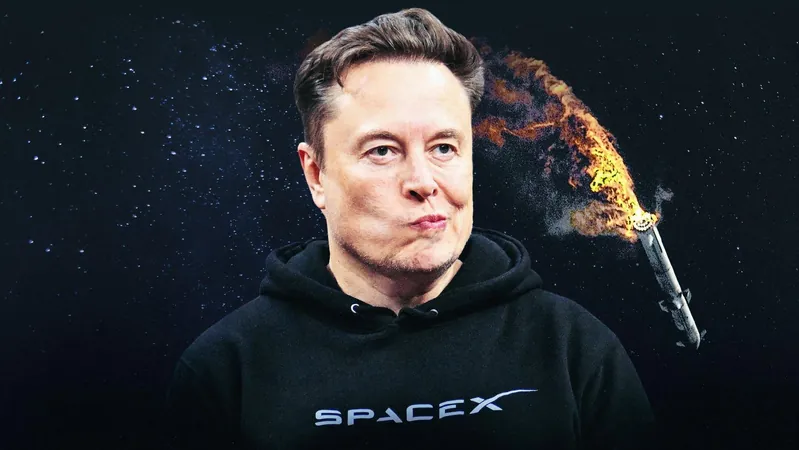
Is SpaceX’s Sky-High Valuation at Risk Following Tesla's Turmoil?
2025-04-09
Author: Ken Lee
As Tesla’s stock takes a nosedive, the future of SpaceX—currently the world’s most valuable private company— hangs in the balance. While the electric vehicle giant grapples with backlash related to Elon Musk's controversial actions, SpaceX remains firmly in the spotlight, yet it could soon face harsh realities.
Elon Musk's ambition of colonizing other planets isn’t cheap, which is why he initially aimed to create affordable rockets at SpaceX. To finance his ambitious ventures, he launched Starlink, a satellite network designed to provide high-speed internet to underserved areas. Musk has quipped that "Starlink is how we are paying for humanity to get to Mars," showcasing his grand vision on social media.
Starlink’s rapid success has been striking. In just under five years, it amassed 5 million subscribers, surpassing former satellite communication leaders, Viasat and Hughes. Investors' excitement over Starlink has helped bolster SpaceX’s valuation, peaking at a staggering $350 billion last December and holding steady even as Tesla's shares plummeted by 55% amidst challenges in sales and public relations.
However, skeptics warn that SpaceX may not be immune to a downturn. The lucrative prospects of Starlink are suddenly under scrutiny, with doubts surrounding whether investors are overlooking the firm’s financial fundamentals in light of Musk’s ambitious claims.
Telecom analyst Tim Farrar has raised concerns, stating, "The valuation isn't consistent with the technical realities of what Starlink currently offers." Indeed, while rockets are thrilling, the market for launching cargo into space is relatively small—only $10 to $15 billion annually, whereas telecom, bolstered by Starlink, is a massive market exceeding $1 trillion.
SpaceX has impressively deployed a constellation of 7,100 satellites—accounting for 62% of all active satellites in orbit. These satellites are already generating revenue by providing internet to planes, ships, and a military-focused version dubbed Starshield. Yet, the real goldmine lies within residential internet access, expected to represent 63% of Starlink’s income this year.
Despite the buzz, Starlink's actual potential faces significant hurdles. Analysts estimate its capacity is currently limited—able to serve only 1–2 customers per square kilometer, which severely constrains profitability in densely populated areas. Their future growth depends on a rollout that must contend with competitors and technological constraints.
Additionally, the path to expansion in places like India appears fraught with challenges. Despite its massive population, only about 3% of Indian households earn over $35,000 a year, posing limits for Starlink's growth prospects there.
Even as the service seeks to gain traction globally, concerns loom regarding Musk's political ties. Countries are reevaluating deals due to backlash over his associations with certain political figures, jeopardizing critical contracts that could shape Starlink's financial future.
Meanwhile, competitors are beginning to emerge, such as Jeff Bezos' Amazon, which is set to launch its satellite constellation, Kuiper, leveraging substantial financial resources and market presence.
While the future growth of SpaceX and Starlink is often tied to its ambitious Starship rocket—the key to developing higher payload capacities—many analysts voice caution. The demand for satellite launches remains generally stable, and the potential for profit in the realm of space tourism is still murky.
Ultimately, investing in Musk's ventures often feels like an act of faith, as financial models struggle to keep pace with his lofty aspirations. As uncertainty looms, all eyes will be on SpaceX to see if it can navigate these turbulent waters and sustain its impressive valuation.



 Brasil (PT)
Brasil (PT)
 Canada (EN)
Canada (EN)
 Chile (ES)
Chile (ES)
 Česko (CS)
Česko (CS)
 대한민국 (KO)
대한민국 (KO)
 España (ES)
España (ES)
 France (FR)
France (FR)
 Hong Kong (EN)
Hong Kong (EN)
 Italia (IT)
Italia (IT)
 日本 (JA)
日本 (JA)
 Magyarország (HU)
Magyarország (HU)
 Norge (NO)
Norge (NO)
 Polska (PL)
Polska (PL)
 Schweiz (DE)
Schweiz (DE)
 Singapore (EN)
Singapore (EN)
 Sverige (SV)
Sverige (SV)
 Suomi (FI)
Suomi (FI)
 Türkiye (TR)
Türkiye (TR)
 الإمارات العربية المتحدة (AR)
الإمارات العربية المتحدة (AR)